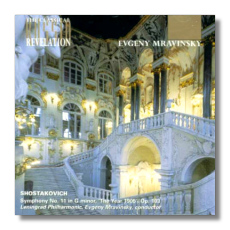
The Internet's Premier Classical Music Source
Related Links
- Shostakovich Reviews
- Latest Reviews
- More Reviews
-
By Composer
-
Collections
DVD & Blu-ray
Books
Concert Reviews
Articles/Interviews
Software
Audio
Search Amazon
Recommended Links
Site News
 CD Review
CD Review
Dmitri Shostakovich

Symphony #11 "The Year 1905"
- Symphony #11 "The Year 1905" in G minor, Op. 103 (1957)
Leningrad Philharmonic Orchestra/Yevgeny Mravinsky
Revelation RV 10091 ADD 60:08
The demand for Mravinsky is so high that some labels will release anything that bears his name, no matter how poorly played or recorded it is. I worried that this CD would be fool's gold – another shoddy live performance of no benefit to the performers, the composer, and the listener. Instead, it's just what we needed: a Shostakovich 11th recorded by its première conductor not long after its first performance, and apparently under controlled conditions. At any rate, there is no trace of an audience, and, more importantly, none of the hazards that come with a live reading. (Russian Disc RD CD 111 57 contains a concert recording from 1957 – just days after the première – which at times is so poorly played that it either makes me cry or fly into in a Mravinskian rage.)
Revelation, a label that specializes in Russian recordings almost entirely unheard in the West, identifies the date of this recording as 2 November 1959. This is two years (less one day) after the Russian Disc performance, but what a difference! This time around, the total timing is more than three minutes slower. These tempos still are faster, however, than those adopted by most Western conductors, sometimes considerably so. For an extreme example, James De Priest's interesting recording with the Helsinki Philharmonic (Delos D/CD 3080) weighs in at a whopping 68:17. Mravinsky accomplishes the difficult task of holding the glacial first movement together as if it were just one gigantic phrase. The frozen, distant fanfares are played with an authority that the Russian Disc performance cannot begin to approach. (Does the word "clam" mean anything to you?) In the second movement, Mravinsky strikes out with malice and brutality; sample the ugly trombone smears at 12:29. The finale is similarly vicious. There are times, though, when I wouldn't mind lingering over details. The second movement's massive climax would benefit from more breathing room, and the elegiac third movement – one of the composer's very finest – is so damn moving that almost any performance of it ends too soon for me.
The only serious shortcoming to this recording is sonic. It's monaural and claustrophobic, and a score as dynamic (in both senses of the word) as this deserves the best technology available. (Stokowski's Houston recording, now on EMI 565206 2, remains an audiophile's delight even four decades after its release.) Still, the music's all there, thanks to the performers' commitment.
Copyright © 1998, Raymond Tuttle


















